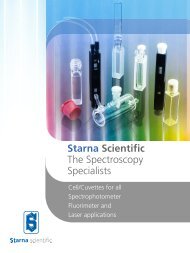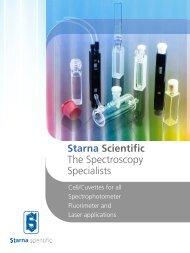You also want an ePaper? Increase the reach of your titles
YUMPU automatically turns print PDFs into web optimized ePapers that Google loves.
Starna ®<br />
Certified Reference Materials<br />
for UV and V<strong>is</strong>ible Spectroscopy<br />
Starna ®
introduction<br />
2<br />
0659<br />
Introduction<br />
UV and V<strong>is</strong>ible Spectrophotometry <strong>is</strong> one of the most common techniques<br />
used in analytical science. Procedures using th<strong>is</strong> methodology<br />
are found in analytical, clinical and research laboratories, and find<br />
extensive use in a Quality Assurance environment. The technique <strong>is</strong><br />
fundamentally both accurate and prec<strong>is</strong>e, but it <strong>is</strong> essential to check<br />
instrument performance on a regular bas<strong>is</strong> to ensure that it <strong>is</strong> within<br />
sat<strong>is</strong>factory parameters i.e. “un<strong>de</strong>r control”, and to allow for corrective<br />
action to be taken when found to be outsi<strong>de</strong> these limits.<br />
With an increasing requirement for laboratories to be accredited<br />
to at least one of the internationally recogn<strong>is</strong>ed standards of GLP,<br />
ISO/IEC 17025 or ISO 9001, th<strong>is</strong> “evi<strong>de</strong>nce of control” has<br />
become an absolute necessity. As has the use of Certified Reference<br />
Materials with a <strong>de</strong>fined traceable path to national or internationally<br />
recogn<strong>is</strong>ed primary materials or procedures.<br />
Optiglass has over thirty years experience in the <strong>de</strong>velopment and<br />
production of Starna ® liquid-filled, heat sealed quartz cells which<br />
possess the good long-term stability and optical properties nee<strong>de</strong>d<br />
to evaluate performance of UV-V<strong>is</strong>ible spectrophotometers. The<br />
range also inclu<strong>de</strong>s solid glass filter materials for both absorbance and<br />
wavelength measurements. The full range of Certified Reference<br />
Materials establ<strong>is</strong>hed traceable to the USA National Institute of<br />
Standards and Technology (NIST) currently available are <strong>de</strong>scribed in<br />
<strong>de</strong>tail in the following pages, together with the necessary information<br />
for or<strong>de</strong>ring a set to meet your exact requirements.<br />
The ability to custom<strong>is</strong>e your requirements <strong>is</strong> unique to Starna ® , and<br />
allows for the compilation of a certified set from available<br />
reference materials.<br />
Qualification of the reference spectrophotometer <strong>is</strong> cons<strong>is</strong>tent with<br />
the most exacting requirements of any regulated environment, and<br />
<strong>is</strong> documented as appropriate on each supplied certificate. In addition<br />
to the measured values, certificates also <strong>de</strong>tail how to use, clean,<br />
and store the Certified Reference Material.<br />
To ensure the on-going quality of the calibration validation<br />
process, recertification of these Certified Reference Materials<br />
<strong>is</strong> an essential requirement, and th<strong>is</strong> process <strong>is</strong> also documented<br />
in the following pages.<br />
Stored, handled, and used correctly Starna ® Certified Reference<br />
Materials have a long working life in providing that essential evi<strong>de</strong>nce<br />
of control for your spectrophotometer.
Frequently asked questions<br />
We are often asked the two primary questions:<br />
<strong>1.</strong> <strong>What</strong> <strong>is</strong> <strong>traceability</strong>?<br />
2. How <strong>is</strong> th<strong>is</strong> <strong>traceability</strong> achieved with<br />
the Starna ® range of Certified<br />
Reference Materials?<br />
Before answering these questions, we must establ<strong>is</strong>h what <strong>is</strong><br />
meant by “Calibration”, and why <strong>is</strong> it important?<br />
• <strong>What</strong> <strong>is</strong> calibration?<br />
Calibration <strong>is</strong> the process of establ<strong>is</strong>hing how the response of<br />
a measuring <strong>de</strong>vice varies with respect to the instrument<br />
parameter being measured. The usual way to perform<br />
calibration <strong>is</strong> to measure the parameter (e.g. using a reference<br />
material) and monitor the instrument response.<br />
• Why <strong>is</strong> it important?<br />
Place any equipment in the environment of choice, and<br />
immediately the chosen environment will begin to act on that<br />
equipment causing change; and ultimately <strong>de</strong>gradation in<br />
performance. Th<strong>is</strong> so called drift, causes your results to become<br />
unreliable and no longer “fit for their inten<strong>de</strong>d purpose”.<br />
Whilst drift cannot be eliminated it can be <strong>de</strong>tected and<br />
contained hrough the process of calibration. In the p[harmaceutical<br />
industry, a system where drift has occurred to an<br />
unacceptable level <strong>is</strong> <strong>de</strong>emed to be “out of control”.<br />
By inference, th<strong>is</strong> same environment will also act on your<br />
Certified Reference Materials to a greater or lesser <strong>de</strong>gree, be<br />
<strong>de</strong>pending on how they are stored, etc. and these materials must<br />
checked/re-certified to ensure that the values on which you are<br />
<strong>de</strong>pending have not also significantly changed.<br />
Starna ®<br />
3<br />
frequently asked questions
frequently asked questions<br />
4<br />
• <strong>What</strong> <strong>is</strong> <strong>traceability</strong>?<br />
National Standards Laboratories (NIST, NPL, etc.) work together<br />
to agree a common <strong>de</strong>finition for measurement units. These then<br />
make up the International System of units, SI. e.g. kilogram, second,<br />
metre, ampere, can<strong>de</strong>la, and the Standards Laboratories will then<br />
“real<strong>is</strong>e” units from internationally agreed SI <strong>de</strong>finitions to establ<strong>is</strong>h<br />
primary national measurement scales.<br />
Traceability <strong>is</strong> <strong>de</strong>fined in the “International Vocabulary of Basic<br />
and General Terms in Metrology (ISO, 1993)” as the…“property of<br />
the result of a measurement of the value of a standard whereby it can<br />
be related to stated references, usually national or international<br />
standards, through an unbroken chain of compar<strong>is</strong>ons all having<br />
stated uncertainties.”<br />
• How <strong>is</strong> th<strong>is</strong> <strong>traceability</strong><br />
achieved with Starna ® materials?<br />
Where appropriate, calibration certificates are <strong>is</strong>sued where<br />
the certification process has establ<strong>is</strong>hed traceable links to a<br />
USA National Institute for Standards and Technology (NIST)<br />
Standard Reference Material (SRM) to <strong>de</strong>termine the appropriate<br />
filter parameters.<br />
Using procedures cons<strong>is</strong>tent with the operation within an<br />
ISO/IEC 17025 environment, all certification measurements are<br />
bracketed by use of an appropriate NIST primary SRM. In<br />
addition the fundamental character<strong>is</strong>tic of the reference<br />
spectrophotometer are periodically establ<strong>is</strong>hed using physical<br />
references. For example, wavelength calibration <strong>is</strong> verified using<br />
line spectra from a mercury em<strong>is</strong>sion source.<br />
• <strong>What</strong> does <strong>traceability</strong> achieve?<br />
Measurements are ma<strong>de</strong> against a cons<strong>is</strong>tent set of units and<br />
there <strong>is</strong> international equivalence of national measurement<br />
scales. It also means that compatible measurements are ma<strong>de</strong><br />
across national bor<strong>de</strong>rs, resulting in unambiguous and reliable<br />
communication of specifications.<br />
• <strong>What</strong> does ISO/IEC 17025 accreditation<br />
achieve?<br />
It provi<strong>de</strong>s an in<strong>de</strong>pen<strong>de</strong>nt third party technical audit on all<br />
processes and procedures performed within the Calibration<br />
Laboratory. Through the International Laboratory Accreditation<br />
Corporation (ILAC), accreditation to the ISO/IEC 17025<br />
standard <strong>is</strong> recogn<strong>is</strong>ed on a world-wi<strong>de</strong> bas<strong>is</strong>.
Care and handling of Certified Reference Materials (RMs)<br />
• Always store the reference(s) in the box when not in use. Handle with extreme care, like any fragile component. Remove dust from<br />
the optical faces by blowing dry air on to the surface.<br />
• Only use a dry optical t<strong>is</strong>sue to remove other contamination. Breakage, scratching of the optical faces, or cracking voids the certification.<br />
• Insert and remove cell based Certified Reference Materials from the instrument cell hol<strong>de</strong>r using the circular top, and make sure not<br />
to place si<strong>de</strong> loads or tw<strong>is</strong>t on the cell.<br />
✓<br />
✗<br />
Starna ®<br />
21<br />
care and handling
eferences<br />
References<br />
Glossary:<br />
Absorbance Negative logarithm (base 10) of the transmittance.<br />
Certified Reference Material A certified reference material <strong>is</strong>sued by Starna ® where the <strong>traceability</strong> has been<br />
establ<strong>is</strong>hed to appropriate NIST Standard Reference Materials (SRMs).<br />
Double Aperture The implicit standard methodology used to calibrate the <strong>de</strong>tector linearity of<br />
national reference spectrophotometers.<br />
Far UV Radiation at the shortwave end of the<br />
UV region. Generally accepted to be<br />
the region between 190 and 250 nm.<br />
GLP Good Laboratory Practice.<br />
ISO 9001 International Standard for quality management and quality assurance.<br />
ISO/IEC 17025 International Standard for the accreditation of Testing or Calibration<br />
Laboratories, formally ISO/IEC Gui<strong>de</strong> 25.<br />
SBW Spectral Bandwidth, also known as Spectral slit width (SSW), spectral bandpass,<br />
and instrument function; a measure of the monochromaticity of the light of a<br />
given spectrophotometer.<br />
Transm<strong>is</strong>sion The process by which radiation passes through material. It therefore represents<br />
radiation that <strong>is</strong> not absorbed, scattered or otherw<strong>is</strong>e d<strong>is</strong>persed by the material.<br />
UV-V<strong>is</strong>ible spectrophotometer An instrument <strong>de</strong>signed to operate through the UV and v<strong>is</strong>ible regions, i.e. from<br />
180 to 800 nm.<br />
Standards:<br />
ASTM E275-01Standard Practice for Describing and Measuring Performance of Ultraviolet, V<strong>is</strong>ible, and Near-Infrared<br />
Spectrophotometers<br />
ASTM E387-84 Standard Test Method for Estimating Stray Radiant Power Ratio of Spectrophotometers by the Opaque<br />
Filter Method<br />
22
Bibliography:<br />
Standards and Best Practice in Absorption Spectrometry<br />
Edited by Chr<strong>is</strong> Burgess and Tom Frost UVSG. ISBN 0-632-05313-5 Blackwell Science<br />
http://www.blackwell-science.com<br />
NIST Special Publication 260-54<br />
Standard Reference Materials:<br />
Certification and use of Acidic Potassium Dichromate Solutions as an Ultraviolet<br />
Absorbance Standard – SRM 935<br />
NIST Special Publication 260-116<br />
Standard Reference Materials:<br />
Glass Filters as a Standard Reference Material for Spectrophotometry – Selection,<br />
Preparation, Certification, and Use of SRM 930 and SRM 1930<br />
NIST Special Publication 260-102<br />
Standard Reference Materials:<br />
Holmium Oxi<strong>de</strong> Solution Wavelength Standard From 240 to 640 nm – SRM 2034<br />
NIST Special Publication 260-140<br />
Standard Reference Materials:<br />
Technical Specifications for Certification of Spectrophotometric NTRMs<br />
Starna ®<br />
23<br />
bibliography
Starna ® accessories<br />
• UHV Cells<br />
• Spectrophotometer Cells • Flow Cells<br />
• Fluorescence Reference Materials • Fluorescence Cells<br />
For further information, contact your local Starna ® representative.<br />
Starna ®<br />
25<br />
Starna ® Brand accessories
Starna ® Cells Inc.<br />
PO Box 1919<br />
Atasca<strong>de</strong>ro<br />
CA 93423<br />
USA<br />
Tel: 800 228 4482<br />
805 466 8855<br />
Fax: 805 461 1575<br />
Email: info@<strong>starna</strong>.com<br />
Local D<strong>is</strong>tributor:<br />
Optiglass Limited<br />
52-54 Fowler Road, Hainault,<br />
Essex IG6 3UT, UK.<br />
Starna ®<br />
Sales & Technical Ass<strong>is</strong>tance<br />
Tel: +44 (0)20 8501 5550<br />
Fax: +44 (0)20 8501 1118<br />
Email: <strong>starna</strong>@optiglass.co.uk<br />
Starna ® Pty.<br />
PO Box 113<br />
Thornleigh<br />
NSW 2120<br />
AUSTRALIA<br />
Tel: 1 800 252 284<br />
+61 (0) 29484 0033<br />
Fax: +61 (0) 29484 0055<br />
Email: info@<strong>starna</strong>.com.au<br />
Starna ®<br />
Starna ® GmbH<br />
Postfach 1206<br />
D-64311 Pfungstadt<br />
GERMANY<br />
Tel: +49 (0) 6157 2813<br />
Fax: +49 (0) 6157 85564<br />
Email: <strong>starna</strong>@t-online.<strong>de</strong><br />
Starna ® GesmbH<br />
Oberneuberg 78<br />
A-8225 Poellauberg<br />
AUSTRIA<br />
Tel: +43 (0) 3335 4850<br />
Fax: +43 (0) 3335 4851<br />
Email: <strong>starna</strong>-austria@netway.at<br />
All rights reserved. No part of th<strong>is</strong> publication may be reproduced, stored in a retrieval system, or transmitted, in any form or by any means,<br />
electronic, mechanical, photocopying, recording or otherw<strong>is</strong>e, without the prior perm<strong>is</strong>sion of Optiglass Ltd.




